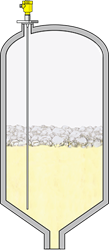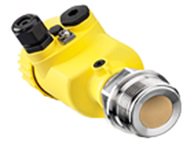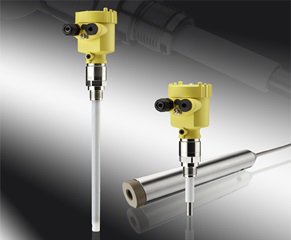Accurate level measurements for foamy applications
When liquids are agitated or mixed with gases, foam is inevitable. It’s why our shampoo creates a thick froth and our favorite carbonated beverages have those pleasant suds sitting atop our drink. For process instrumentation and measuring the level, however, those satisfying bubbles pose some real challenges, causing the process engineers trying to get an accurate liquid level to foam over with frustration.
This foamy issue isn’t limited to the chemical or the food and beverage industries like the examples mentioned above. Foam affects processes across all industries using liquids. To overcome those challenges, there are a couple of best practices for getting an accurate continuous level measurement inside a tank or vessel.
A short supply of choices
The standard for cutting through foam
 Guided wave radar is usually a top choice when the conversation turns to foam. That’s because this technology has a long and successful history of making accurate liquid level measurements when any amount of foam is present, regardless of the vessel pressure or the product temperature or density.
Guided wave radar is usually a top choice when the conversation turns to foam. That’s because this technology has a long and successful history of making accurate liquid level measurements when any amount of foam is present, regardless of the vessel pressure or the product temperature or density.
Guided wave radars use a cable, rod, or other type of transmission line inserted into the substance to make the measurement. Once installed, a low amplitude, high-frequency microwave pulse is sent along that line, and the instrument is able to calculate distance by measuring the time it takes for the pulse to reach the surface of the liquid. This signal is able to move right through any foam on top of the liquid because the instrument only sees the foam as additional airspace.
Guided Wave Radar Limitations
Using pressure to ignore the foam
 Pressure transmitters are another superb option when it comes to getting a level measurement when foam is present. Hydrostatic pressure can provide an accurate, reliable level measurement of the liquid inside a tank or vessel while ignoring the foam. The pressure transmitter is installed near the bottom of the tank with the instrument’s measuring cell touching the liquid, and using the mass of the stationary liquid above it and the liquid’s known density, the sensor is able to calculate an accurate level.
Pressure transmitters are another superb option when it comes to getting a level measurement when foam is present. Hydrostatic pressure can provide an accurate, reliable level measurement of the liquid inside a tank or vessel while ignoring the foam. The pressure transmitter is installed near the bottom of the tank with the instrument’s measuring cell touching the liquid, and using the mass of the stationary liquid above it and the liquid’s known density, the sensor is able to calculate an accurate level.
The pressure sensor can make an accurate level measurement despite foam because the foam is made up of mostly gas and has little to no effect on the hydrostatic pressure measurement. Also, the only contact with the liquid is at one small point near the bottom of the vessel, so mixers and heating coils don’t interfere with the measurement, either. Using pressure to measure inside a foamy vessel can have its drawbacks, however.
Pressure’s Limitations
Hydrostatic pressure sensors work best when the liquid being measured maintains a constant density. If the density changes due to temperature or composition, there will be a comparable fluctuation in the level output as the actual level stays the same. Fortunately, this minor setback can be overcome by using two pressure sensors.
Differential pressure uses two pressure sensors to measure level. VEGA uses differential pressure in a slightly different way when a fluid in an unpressurized tank or vessel has a changing density. This is called density compensated level. In this application, two independent pressure sensors are submerged at different levels in a fluid, and the density is calculated based on the changing differential pressure. This density value is used with the lowest pressure sensor’s output to determine overall level. VEGA offers electronic differential pressure for these types of scenarios, which means no capillaries are needed for remote seal installations, and the level remains accurate independent of the density changes.
A third and fourth option for point-level applications
 If operators only need to know when a vessel or tank reaches a certain point, then a point-level switch is another viable option. However, not all switching technologies operate the same. When it comes to most liquids, vibration and capacitance are two of the most common switching technologies, and each can tell an operator different information, depending on what is needed for the application.
If operators only need to know when a vessel or tank reaches a certain point, then a point-level switch is another viable option. However, not all switching technologies operate the same. When it comes to most liquids, vibration and capacitance are two of the most common switching technologies, and each can tell an operator different information, depending on what is needed for the application.
Vibration switches are contact instruments that vibrate at a specific frequency. Once a liquid comes into contact with the switch, the frequency changes, which activates the output. Because foam is made up of mostly air, a vibration switch will not activate until it comes into contact with the liquid underneath the foam.
Capacitance switches, on the other hand, measure a liquid’s ability to hold an electrical charge, and these switches look for step changes in standing capacitance. This is why these sensors can be calibrated to detect the foam level sitting atop the liquid. This can be especially useful in applications where foam overs are a concern.
Conclusion
Related products
Export this article
Download as PDFShare this article
Comments ({{comments.length}})
{{getCommentAuthor(comment, "Anonymous")}} {{comment.timestamp | date : "dd.MM.yyyy HH:mm" }}
{{comment.comment}}





